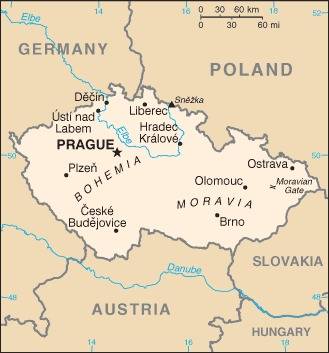62 Czechia

Two equal horizontal bands of white (top) and red with a blue isosceles triangle based on the hoist side.
Flag courtesy of the CIA World Factbook

Map courtesy of the CIA World Factbook

The Church of Our Lady before Tyn (also known as the Tyn Cathedral) overlooks Old Town Square in Prague.
Photo courtesy of the CIA World Factbook
Government
According to Britannica, on December 16, 1992, the Czech National Council adopted a new constitution establishing the Czech Republic as a parliamentary democracy. This document reflects the Western liberal tradition of political thought and incorporates many of the principles codified in the Charter of Fundamental Rights and Freedoms, which was adopted by the former Czechoslovak Federal Assembly in January 1991. The constitution provides for a bicameral Parliament consisting of a Chamber of Deputies (elected on a proportional basis for four-year terms) and a Senate (elected on a district basis for six-year terms).
Executive power is shared by the prime minister and the president. Directly elected by popular vote to a five-year term, the president, who is also the head of state, appoints a prime minister, who heads the government and advises the president on the appointment of other members of the government.
The Czech Republic was formerly divided into 77 okresy (districts). These units are still recognized, but in 2000 the country reestablished 13 kraje (regions) and one hlavní mesto (city) that reflect administrative divisions in place from 1948 to 1960. Local governments have the power to raise local taxes and are responsible for roads, utilities, public health, and schools.
The Czech Republic’s judicial system consists of the Constitutional Court, the Supreme Administrative Court, and the Supreme Court as well as high, regional, and district courts. Military courts are under the jurisdiction of the department of defense. During the 1990s, the Czech government took steps to modify its legal system (based on pre-1918 Austrian criminal code) to meet standards set by the Organization for Security and Co-operation in Europe.
Civil Aviation Authority of the Czech Republic
In 1997, the Civil Aviation Authority of the Czech Republic was established under Section 3 of the Act No. 49/1997 Coll. on Civil Aviation. In 2018, Regulation (EU) 2018/1139 of the European Parliament and of the Council of 4 July 2018 on common rules in the field of civil aviation and establishing a European Union Aviation Safety Agency entered into force.
Airspace
SkyVector – Google Maps – ADS-B Exchange
ICAO countries publish an Aeronautical Information Publication (AIP). This document is divided into three parts: General (GEN), En Route (ENR) and Aerodromes (AD). ENR 1.4 details the types of airspace classes they chose to adopt from classes A through G.
Drone Regulations
Advanced Air Mobility (AAM) Regulations & Policies
Bilateral agreements facilitate the reciprocal airworthiness certification of civil aeronautical products imported/exported between two signatory countries. A Bilateral Airworthiness Agreement (BAA) or Bilateral Aviation Safety Agreement (BASA) with Implementation Procedures for Airworthiness (IPA) provides for airworthiness technical cooperation between the FAA and its counterpart civil aviation authorities.
Reciprocal acceptance of aviation safety-related approvals and services with the European Union Aviation Safety Agency (EASA) and Member States of the European Union are primarily governed by the U.S. – European Union Safety Agreement.
Advanced Air Mobility (AAM) News
2025 – AAMG invests in Zuri’s plans to develop eVTOL aircraft
2025
Video courtesy of Advanced Air Mobility Institute from the July 2025 Global AAM Forum.
2025
Video courtesy of Advanced Air Mobility Institute from the January 2025 Global AAM Forum. Complete session for Day 1 of this Forum is available on the Advanced Air Mobility Institute YouTube Channel
Short Essay Questions
Scenario-Based Question
You have been hired by a Drone Startup Company. Your boss has immediately assigned this job to you.
They need you to prepare a one-page memo detailing the legalities of using a drone to film the old town square in Prague, pictured above.
They need you to mention any national laws and local ordinances.
They specifically want to know what airspace (insert pictures) you will be operating in and whether or not you need an airspace authorization.
Does it matter whether or not you are a citizen of the country?
Lastly, there is a bonus for you if, as you scroll through this chapter, you find any typos or broken links!
Short Essay Questions
- What are the drone categories?
- How is registration addressed?
- How is remote ID addressed?
- What are the model aircraft rules?
- What are the commercial drone rules?
- Are there waivers or exemptions to the rules? If so, for what?
- Would you share a link to an interactive airspace map?
- How is BVLOS addressed?
- How can you fly drones at night?
- How can you fly drones over people?
- Where do you find drone NOTAMs?
- What are the rules for drone maintenance?
- What are the rules for an SMS program?
- What are some unique rules not mentioned above?
- What are the C-UAS rules?
- What are the AAM rules?

